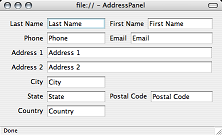XTech 2007 Summary
A short post with the best things -
- Joost demo - I need them to open source their sprite code as well as using the XULRunner base, or I'll have to write the same thing at work. It also would make a better platform for the UML modelling and SAM meta-tool stuff I used to do. Maybe they'll turn up on Mozpad.
- XMPP pushing - Several demos of making interactive applications on top of XMPP, and a cute demo of SamePlaceSuite, which I got my sister to install this evening; Strange Attractor have a fuller write up of the Jabber and ubi-comp talks.
- Arduino hacking - I first got into computers after messing around with analogue electronics, light sensors and making motors go on and off. This is the sort of thing I could make cool stuff for my nieces with, who might get tempted to take things apart. There seems to be a generation of programmers today who don't have any idea of the hardware below, because there's so many layers in modern systems; I don't know how many CS courses still have obligatory hex microprocessor programming sections now that microprocessor instructions are several times as long and have a multitude of addressing modes. 6800 was much simpler than modern cores, Arduino seems simpler still.
- Joins on open data - several talks mentioned using joins across open data sets, for example tags on photos with geolocation data can be used to infer tags for the locations, and also many cases of joins across datasets for space and time visualisation in stamen.com's talk.
- The eponymous stamen.com talk on interactive visualisations - but with very little actual interaction. They create beautiful, information rich applications, many simply play through a time selection and give a video scrub control, and you watch a population of events evolve in a space. The information-software as branch of movie making metaphor.
- Interaction embodiments - Nabaztag and Matt Webb and others, using simple metaphors and littoral devices which span between physical and web spaces. I like physical things that do one thing; gestures and simple control. I hate trying to do anything detailed with a mouse, though a trackpad is ok - something like drawing with your fingertips, and stylus or touch screen is much better. That most of the physical interaction we have with computers is with a soap-on-a-rope always strikes me as odd (they also hurt my wrists if I do use them, but that's another issue). I'm still waiting for the nanotech to get to the state that I can write code in my moleskine and it will execute and report the result on the next line of paper.
- Together-apart-together-apart flows in information/interaction embodiments and mediated spaces/private spaces. The dumber the network - and xmpp is pretty dumb - the more diverse the messages; getting information software as rich as print media and interaction as easy as a pocket book is hard. But fun hard.
Pete
Labels: javascript, ubiquitous-computing, xmpp, xtech07, xul


